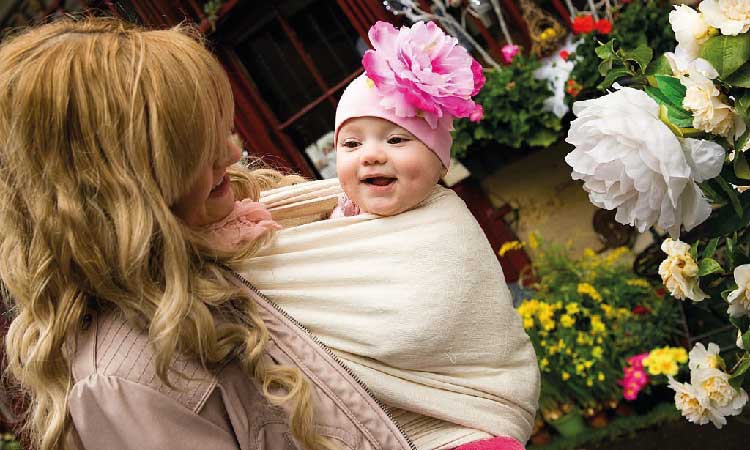Baby-wearing is something that most new or soon-to-be parents have heard of. Baby-wearing, which involves using a sling or carrier to carry infants and toddlers, is a practice that is gaining popularity among parents all over the world. Both babies and caregivers can greatly benefit from this ages-old custom that has roots in many different cultures.
Beyond the psychological and physiological benefits, baby-wearing also has practical advantages. In addition to freeing up parents’ hands, it allows them to take care of daily tasks while simultaneously keeping their children entertained.
Baby-wearing is emerging as a useful tool for soothing and caring for newborns, building the parent-child bond, and promoting holistic development as interest in natural parenting techniques rises. But is baby-wearing safe?
When practiced with proper technique and safety guidelines, this technique is a safe and beneficial way to carry infants and toddlers. To learn more about the health benefits of baby-wearing, keep reading.
What Is Baby-wearing?
The practice of wearing a baby close to one’s body in a sling or other similar carrier is known as baby-wearing. It enables parents or other caregivers to hold their babies close and securely while freeing their hands. Baby-wearing has many advantages, including fostering attachment and bonding, making breastfeeding easier, calming babies, and supporting their physical and emotional growth.
Additionally, it enables parents to carry out daily tasks with ease while still keeping their children snuggled up close to them. Baby-wearing has a long cultural history and has become more widespread recently as more parents become aware of its benefits.
Related Reading: 10 Simple And Effective Tips To Clean Baby Toys
However, following a baby-wearing guide is crucial for ensuring the safety and well-being of both the caregiver and the baby. It provides valuable instructions on proper positioning, securing the carrier, and distributing weight evenly, reducing the risk of discomfort or injury.
It is important to position the baby properly while baby-wearing. Knowing the TICKS for baby-wearing is crucial. TICKS is an acronym that stands for:
T: Tight: Ensure that the carrier is snug and secure, with no slack that could lead to your baby slumping down.
I: In view at all times: Your baby’s face should always be visible, without any fabric or material blocking their airway.
C: Close enough to kiss: Your baby’s head should be positioned high enough on your chest that you can easily lean down and kiss the top of their head.
K: Keep the chin off the chest: Make sure there is always a visible gap of at least one finger width between your baby’s chin and chest to allow for proper airflow.
S: Supported back: Ensure that your baby’s back is well-supported in a natural, curved position, and avoid carriers that force their spine into a straight position.
Also,
- Young babies should always be held with their faces facing the person holding them. Your baby can be monitored better and ensure that they are always in the correct position on your chest if you carry them with their face facing you
- The legs of your infant should form an “M” or frog shape with their knees bent and hips spaced widely. Ideally, your baby’s stomach and chest should rest against yours
- It is important to support their heads, especially if they are newborns
- Your baby’s head and face should always be visible; neither the carrier nor any other fabric should ever block their view
- Keeping your baby cool while baby-wearing is important, especially during hot weather or in warm environments. For this, you can opt for carriers made from lightweight, breathable materials such as cotton, linen, or bamboo.
When should I start wearing my infant? That may be the next question. Baby-wearing can begin the day your child is born. However, there is one condition. You must do it correctly and with the appropriate wrap. The process can be easily started after the infant is one month old. You may continue to reap the benefits of baby-wearing as your child grows into a toddler.
Related Reading: 9 Home Remedies For Colic In Babies
Top 10 Benefits Of Baby-wearing

Many New mothers frequently have a never-ending list of tasks to complete. And, more often than not, women/caregivers must hold their babies while doing their tasks. If you carry a baby around all day, it might seem incredibly heavy, but sometimes a busy mother doesn’t have much of a choice. This is where the significance of baby-wearing comes into play.
Explore ten key benefits of baby-wearing that make it a cherished practice for many parents and caregivers.
1. Promotes bonding
Baby-wearing has advantages for the mental and emotional development of the baby as well. According to studies, carrying a baby close to one’s body fosters attachment and bonding.
Additionally, moms can learn to better understand their baby’s needs while baby-wearing. This is one of the top benefits of baby-wearing for moms. The baby will not need to cry out loud to let the mom know what it needs. Before it gets to that point, she will begin recognizing their cues.
As a result, the mother will feel more assured in her parenting abilities. A happier, more contented baby results from this bonding experience because it helps develop trust and security1.
2. Boosts cognitive development
Babies who are carried close to their parents or other caregivers have many opportunities to look out at the world from a secure vantage point. They can actively engage with their surroundings, benefiting from a wider range of sensory experiences.
This exposure to stimuli supports cognitive development2, language acquisition, and overall curiosity about the world.
3. Baby-wearing has orthopedic advantages
How an infant is placed in daily life may have an effect on how their hips develop. Baby-wearing has been linked to hip health in studies. Furthermore, it is hypothesized that inward-facing baby-wearing may result in increased muscular activation of the lower limbs. A new experimental study on infant biomechanics suggests that upright, inward-facing baby-wearing may have a positive effect on the neck muscles’ development.
The infant hip dysplasia braces and harnesses place the babies’ legs in the same flexed, outward position as many baby carriers. This finding led experts to conclude that baby-wearing in the “M” position with the hips flexed and abducted is beneficial for healthy hip development3
Baby-wearing also aids in strengthening the neck and core muscles4.
4. Assists in soothing fussy babies
The gentle motion and rhythmic swaying while baby-wearing mimic the sensations felt in the womb. These familiar movements can calm fussy or colicky babies, helping them regulate their breathing, heart rate, and overall state of well-being.
The closeness to the mother’s body and the sound of her heartbeat provides a soothing environment that reassures the baby. According to studies, wearing a baby for the first few months can significantly reduce crying by 43%. Plus, it cuts down on crying by 51% during those important hours in the evening when you’re trying to sleep.
5. Contributes to breastfeeding in many ways
Baby-wearing facilitates breastfeeding since it provides some convenience as well as freedom. The proximity and skin-to-skin contact encourage the hormone oxytocin, which is in charge of milk letdown, to be produced.
Providing regular and practical feeding opportunities also aids in the development of a stronger nursing bond. One of the benefits of baby-wearing for babies is that it makes latching easier.
It might be challenging to breastfeed if you’re not at home. It might be difficult to get your infant to discover your nipple and latch on properly if you wear a blanket to cover up when nursing. But with a baby carrier, your infant will already be snuggled up on your chest, which is very near the ideal spot. It makes it easier for the baby to discover your nipple and latch on to you more effortlessly.
Related Reading: How To Dress Baby For Sleep In Summer – 11 Tips Ensure Comfortable Sleep
6. Provide more freedom of movement
Mothers are multitaskers. Carrying a baby in their hands and doing chores can hurt their hands badly. The freedom it gives parents is one of the most important practical benefits of baby-wearing.
With their hands and arms free, parents can take care of daily responsibilities, indulge in hobbies, or look after older siblings while still holding and protecting their baby. This capacity for multitasking fosters parental well-being and increases their self-assurance.
7. It allows parents to expose their babies to more of the world
Your baby is more likely to be socially engaged when they are worn rather than placed in a stroller or a car seat. Often, they will hear you talking to others as well as to yourself, which will help them improve their language skills.
Furthermore, the many places in which they will find themselves will excite their senses. They will feel what it is like to walk when you are moving; they will also feel what it is like to stop abruptly or turn around. A newborn may find changes in the environment and activity fascinating.
It also guarantees that you and your infant have a comfortable navigation experience. Baby-wearing allows caregivers to explore various environments without the constraints of a stroller or other bulky equipment. When you’re on a packed sidewalk, it might be difficult to find enough space to push your stroller.
Baby-wearing may also make it easier to wander through parks, beaches, and zoos, fostering the baby’s curiosity and exposure to different sensory stimuli. This exploration contributes to their overall development and understanding of the world.
8. Promotes the physical health of mothers
Baby-wearing provides significant benefits for a mother’s physical health. By carrying their baby in a sling or carrier, mothers engage in gentle exercise throughout the day, promoting increased activity and calorie expenditure. The weight of the baby acts as resistance, helping to strengthen and tone muscles, particularly in the core, back, and arms.
Additionally, baby-wearing encourages good posture, as the mother adjusts her stance to maintain balance and support the baby’s weight. This can alleviate strain on the back and shoulders, promote better spinal alignment, and reduce the risk of muscular imbalances or discomfort.
Overall, baby-wearing offers mothers a practical and enjoyable way to stay physically active while caring for their little ones.
Related Reading: 15 Easy Tips To Lose Weight After Delivery
9. Assists in relieving gastrointestinal discomfort
Babies often experience discomfort from gas, reflux, or colic. The upright position in a carrier helps alleviate these issues by applying gentle pressure on the baby’s tummy, aiding digestion, and reducing reflux symptoms. The closeness to the caregiver’s body also provides additional warmth, which can soothe abdominal discomfort.
10. Offers safety and comfort in crowded settings
Baby-wearing creates a barrier of protection between the infant and potential dangers in crowded or busy areas. It keeps strangers from approaching too closely, lessens contact with germs, and makes sure the baby is secure and comforted in the face of outside stimuli. Additionally, it makes it possible for parents to keep a close eye on their children.
How Long Is It Safe To Baby Wear?

The duration of safe baby-wearing depends on various factors, including the baby’s age, developmental stage, and individual needs. Generally, baby-wearing is considered safe from birth until the toddler stage. Newborns can be carried for extended periods as they require constant closeness and comfort.
Parents can continue to baby-wear a child as it grows and gains control of his or her head and neck. They should also make adjustments to suit the child’s changing needs and preferences. However, it is important to take breaks and allow both the caregiver and baby to rest, ensuring that prolonged baby-wearing does not lead to fatigue or discomfort.
Related Reading: New-Born Care After Delivery At Home: 9 Practical Tips
5 Negative Effects Of Baby-wearing
While baby-wearing has numerous benefits, it’s important to acknowledge that there can be potential negative effects. Here are five negative effects of baby-wearing to consider:
- Discomfort and strain: Improper positioning or prolonged periods of baby-wearing can lead to discomfort and strain for the mother. Carrying a baby for extended periods without breaks or using carriers that don’t provide adequate support may cause muscle fatigue, back pain, or shoulder strain
- Baby-wearing can limit a parent’s range of motion: Baby-wearing may restrict the parent’s movements, especially when performing tasks that call for a lot of bending or arm movement. This limitation may make it challenging to perform certain tasks comfortably or hinder participation in activities that require unrestricted mobility
- May increase body temperature and sweating: Baby-wearing can lead to increased body heat for both the parent and the baby, especially in warmer climates or during prolonged wear. Insufficient ventilation or improper clothing choices may result in excessive sweating, discomfort, or even overheating. Parents should be mindful of temperature regulation and ensure the baby remains comfortable
- Not suitable for babies with certain medical conditions: Baby-wearing may not be suitable for babies with certain medical conditions or physical impairments. Conditions such as hip dysplasia or spinal abnormalities may require specific types of carriers or alternative caregiving methods. It is crucial to consult with a healthcare professional to ensure baby-wearing is safe for the baby’s specific needs
- Finding the right carrier can be challenging: Finding the perfect carrier that suits both the mother’s and the baby’s comfort can be a trial-and-error process. Different carriers have various features, sizes, and styles, and what works well for one caregiver may not work for another. It can be time-consuming and expensive to find the right fit, leading to frustration and dissatisfaction
It’s essential to note that many of these negative effects can be mitigated by following proper baby-wearing guidelines, using ergonomic carriers, taking breaks when needed, and ensuring the baby’s comfort and safety at all times.
When To Stop Baby Wearing?
With all of the pros and cons of baby-wearing, it should be phased out at some point. The decision to stop baby-wearing ultimately depends on the caregiver and the child’s preferences, comfort, and developmental stage. As children grow, the need to be carried may decrease as they become more independent and mobile.
When a child begins to walk confidently or expresses a desire to explore their surroundings without being carried, parents may choose to discontinue baby-wearing. It is crucial to keep in mind that there is no set age or duration at which baby-wearing must cease.
Some parents continue to babysit their children even after they reach the toddler stage if it benefits both the child and the caregiver. The choice to stop baby-wearing is ultimately a personal one, so it is critical to take the child’s unique needs, comfort, and developmental milestones into account.
Conclusion

Finding a baby carrier is never difficult. There are many different types of baby carriers. Although some baby carriers can be made at home, most are purchased from shops. Depending on what you’ll be doing and your baby’s age, you could discover that some of them work better than others.
Whatever carrier you decide on, be sure to read the included directions and comprehend how to use it securely. However, there are several considerations you should make, including your comfort and the baby’s posture. You must make sure that both you and your child feel at ease while wearing them. You should choose a carrier that is comfortable because there will be days when you may have to wear your child for several hours.

